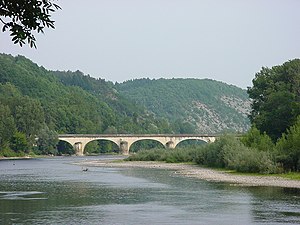Dordogne Bridge from Souillac
Coordinates: 44 ° 52 ′ 59 ″ N , 1 ° 29 ′ 7 ″ E
| Dordogne Bridge from Souillac | ||
|---|---|---|
| Subjugated | Dordogne | |
| place | Souillac | |
| construction | Stone arch bridge | |
| overall length | 180 m | |
| Number of openings | 7th | |
| Clear width | 22 m | |
| Arch thickness (vertex) | 1.2 m | |
| Arch slenderness | 1:18 | |
| start of building | 1812 | |
| completion | 1824 | |
| location | ||
|
|
||
The Dordogne bridge of Souillac ( French: Pont de Souillac; Pont Louis Vicat ) is a stone arch bridge that crosses the Dordogne on the southeastern outskirts of Souillac in the French department of Lot and thus establishes the connection via the D 820 to Cahors and Toulouse in the south. Its official name is Pont de Lanzac after the place on the other bank.
The 180 m long bridge has seven somewhat flattened arches with a span of 22 m each between massive, wide pillars. It replaced a ferry that could no longer handle the traffic. Its construction was started in 1812 by the then 26-year-old Louis-Joseph Vicat , an engineer from the École Nationale des Ponts et Chaussées . Due to financial difficulties, he was not able to complete it until 1824.
The Dordogne, which was at times raging floods, made it possible to expect considerable difficulties in the foundation of the bridge piers. Vicat began his experiments with hydraulic limes here in order to find a binding agent that would harden faster than the previously common mixtures of lime, ground bricks and iron slag. He eventually invented artificial hydraulic lime and published his results, laying the foundations for an understanding of both cement and lime mortar. With the approval of the Commission for Roads and Bridge Construction, he was able to use his invention on the foundations of the Dordogne bridge. A plaque on the bridge reminds of this.
If the Dordogne bridge is sometimes referred to as the first large concrete bridge, this is only correct with the caveat that the hydraulic lime invented by Vicat was a forerunner of cement and did not produce concrete in today's sense, and Vicat only used the new building material in the foundations and pillars, but not in the stone arches.
The Dordogne Bridge acquired a certain importance with regard to the development of the statics of the bridge arches, when Vicat was one of the first to observe and follow the periodic opening and closing of the joints on the clamped arches depending on the temperature, but this did not pose any problems for the stability of the bridge derived.
Web links
- Dordogne Bridge from Souillac. In: Structurae
- Volker Wetzk: Development of the bridge bearings - historical overview (PDF file; 61 kB) In: Bautechnik 83 (2006), no. 10, pp. 721–732. ISSN 0932-8351 (accessed January 27, 2010)
- Vicat: News of the observations of a periodic movement of the vaults of the bridge over the Dordogne near Souillac , Journal für die Baukunst, Volume 4, G. Reimer, Berlin, 1831 (digitized from Google books, accessed on January 27, 2010)

